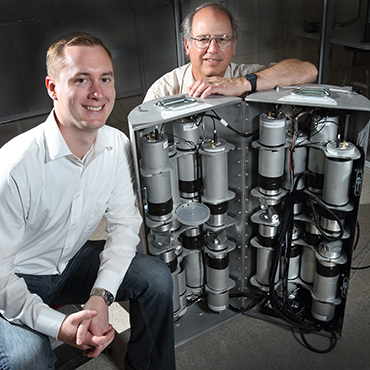Finding nukes faster

Sandia has tested a new lightweight, portable technology that can image an entire building at a glance.

Sandia National Laboratories' Mark Gerling, left, and John Goldsmith demonstrated the effectiveness of the Mobile Imager of Neutrons for Emergency Responders during an exercise in Chicago. (Photo by Dino Vournas)
It's a device almost tailor-made for "24's" Jack Bauer: a detector that can "see" through a downtown high-rise building and find a terrorist's hidden nuclear weapon without a door-to-door search.
Thoughts of terrorists hiding nuclear devices inside buildings in major metropolitan areas have haunted homeland security and emergency responders for years. The fixed field-of-view radiation detectors and backpack-based detection devices that are traditionally used to find nuclear devices do not have a wide-angle view.
A new portable radiation imaging device under development at Sandia National Laboratories could ease those fevered dreams by allowing searches to be broadened.
The lab has already tested the lightweight, portable technology, which can image an entire building at a glance to find dangerous radioactive devices. Researchers used the system to find a dummy nuke placed by federal authorities during a drill in Chicago earlier this year, Sandia officials said in an Oct. 30 statement detailing the technology.
During the Chicago exercise, Sandia's Mobile Imager of Neutrons for Emergency Responders (MINER) found a sealed radiation source that mimicked the radioactive signature of more lethal and dangerous radioactive material, even through shielding.
"The system performed exactly as we expected," Sandia physicist John Goldsmith said in Sandia's statement. "With an unshielded source, we pinpointed the location within 30 minutes. With more shielding, it took a couple of hours."
Weighing in at 90 pounds and standing 3 feet tall, MINER is a battery-operated version of the lab's 5-foot-tall neutron scatter camera. Both systems can discern between threatening forms of radiation, background radiation and radiation used in legitimate applications, according to Sandia. Funding for MINER's development came from the Office of Defense Nuclear Nonproliferation Research and Development in the Energy Department's National Nuclear Security Administration.
MINER's capabilities allow it to distinguish plutonium, a threat source, from AmBe, which is the most common commercial source of neutrons but not a threat, researchers said.
Additionally, Sandia said MINER provides omnidirectional imaging, which gives it the ability to survey much larger areas for threatening radiation hot spots.
During the Chicago trial, researchers "imaged part of one side of an entire high-rise building at once and narrowed the search to a specific room," Sandia physicist Mark Gerling said. "It's extremely effective in this situation."
Although emergency responders' backpack-based radiation detectors might be faster at pinpointing a dangerous radiation source, that source might not be accessible on foot. That's where MINER could come into play, according to Sandia.
Officials said future work on MINER includes expanding and refining its measurement capabilities and participating in a search scenario at sea.


